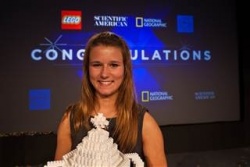Girl builds artificial ‘brain’ to detect breast cancer
An artificial “brain” built by a 17-year-old whiz kid from Florida is able to accurately assess tissue samples for signs of breast cancer, providing more confidence to a minimally invasive procedure. The cloud-based neural network took top prize in this year’s Google Science Fair.

“I taught the computer how to diagnose breast cancer,” Brittany Wenger, the Lakewood Ranch resident, told John Roach. “And this is really important because currently the least invasive form of biopsy is actually the least conclusive, so a lot of doctors can’t use them.”
Wenger wanted to create a way for more doctors to use the minimally invasive procedure, called Fine Needle Aspirate, in order to ease the process of having lumps examined. Breast cancer affects one in eight women worldwide, she noted, including members of her family.
“Early detection is really important,” Wenger said. “And that is what I’m trying to do with my neural network.” Artificial neural networks are essentially computer programs coded to think like the brain, she explained. Only they can detect patterns that are too complex for mere humans. And they get better as they process more and more data.
Wenger started building these networks in the seventh grade after studying the future of technology for a school project. “I came across artificial intelligence and was just enthralled. I went home the next day and bought a programming book and decided that was what I was going to teach myself to do,” she said. Her first neural network played soccer.
For her Google Science Fair project, she built a neural network with Java and then deployed it to the cloud. She ran 7.6 million trials on it and found it is 99.1 percent sensitive to malignancy. “As I get more data, the success rate will go up and the inconclusive rate will go down,” she said. “So with more data, I think it is hospital ready.”
She also compared her custom-built network to three off-the-shelf products that she tweaked to work with her dataset. Her sensitivity to malignancy was 4.97 percent better than the commercial networks. Now that her network is built and shown to get smarter with experience, Wenger aims to deploy it in hospitals. She also wants to extend it to other types of cancer. “It will require a little bit of coding and tweaking, but it would be very easy to adapt it so it could diagnose other types of cancer and potentially other medical problems,” she said.
Before she gets cracking, though, Wenger deserves to bask in the glory of victory. The grand prize comes with $50,000 in scholarship money, an internship with a fair sponsor and a 10-day trip to the Galapagos Islands. “I’ve never been to South America,” she said. “I’m so excited.”
To learn more about Wenger’s project and the other finalists, check out the Google Science Fair.
Author: John Roach is a contributing writer for NBCNews.com.
Source: http://www.futureoftech.msnbc.msn.com
26.07.2012











